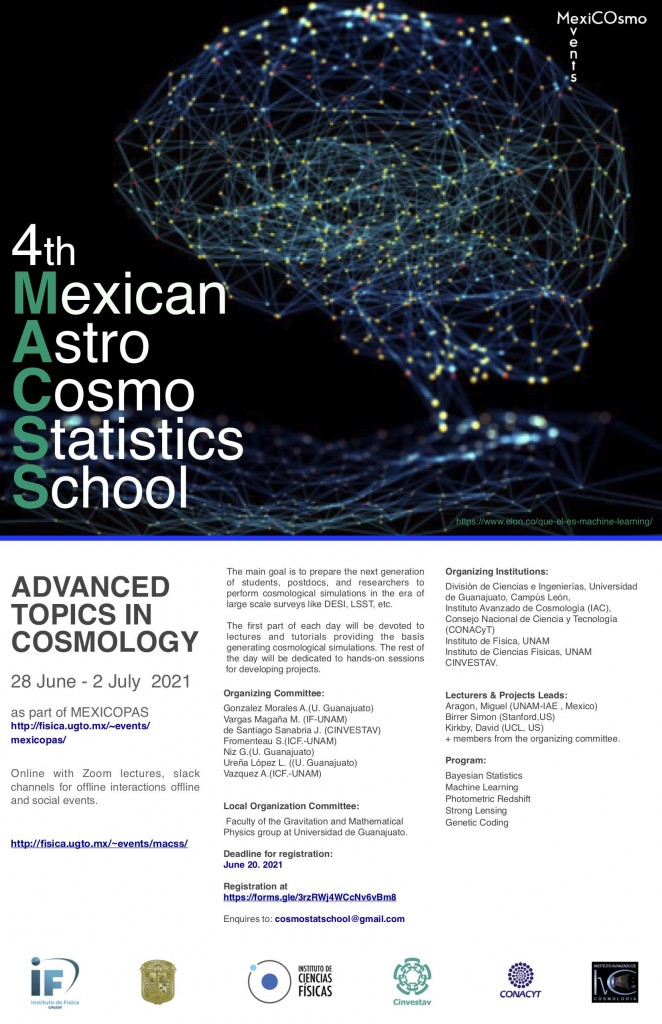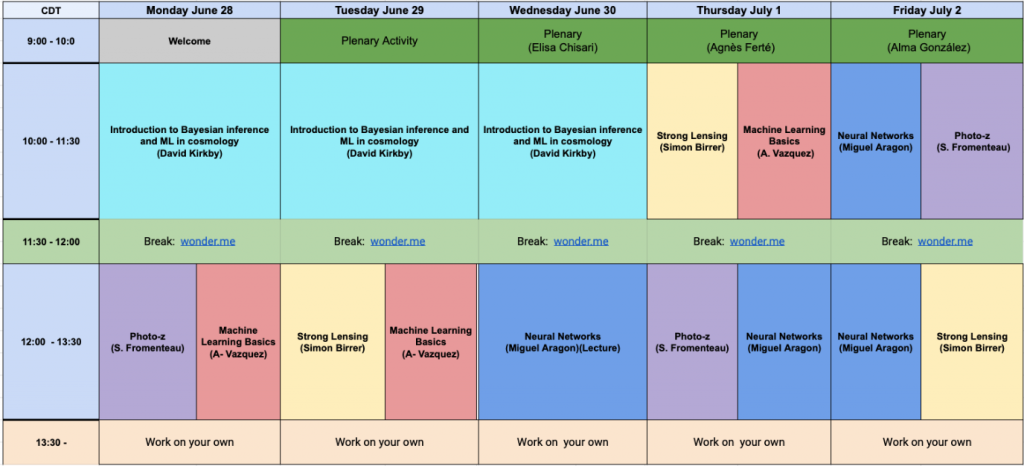
Advanced topics in Cosmology
June 28 – July 2, 2021
Location: The school will be virtual!
The main goal of this school is to prepare the next generation of students, postdocs, and researchers to perform statistical analysis over cosmological observations, such as present large scale surveys like DESI and VERA RUBIN C. OBSERVATORY.
The first part of each day will be devoted to lectures and tutorials providing the basis of the advanced topics. The rest of the day will be dedicated to hands-on sessions for developing projects. A set of projects will be pre-defined.
Lecturers and project leads
-
Miguel A. Aragon (UNAM-IAE)
-
Simon Birrer (Stanford University)
-
David Kirkby (University of California Irvine)
-
+ Some members from the organizing committee
-
Bayesian statistics
-
AI and ML in cosmology
-
Strong and weak Lensing
Schedule
- Virtual meeting from 9am to 1.30pm
- Work (special projects) on your own from 1.30pm onwards
All lectures and material for the projects will be at https://github.com/cosmostatschool/MACSS2021
Plenaries:
– Introduction to Bayesian Inference and Machine Learning, David Kirkby
– Intrinsic alignments: cosmology and galaxy evolution, Elisa Chisari,
( Institute for Theoretical Physics of Utrecht University.)
– Testing cosmological models with weak gravitational lensing, Agnès Ferté (Jet Propulsion LaboratoryCalifornia Institute of Technology)
– Mexican participation in DESI and LSST prospects and opportunities. Alma González (Universidad de Guanajuato)
Project descriptions:
– Photo-z: The idea of this project is to learn the basics about photometric redshift estimation. You will use magnitude evolution for elliptical galaxies (also known as red galaxies) pre-calculated using the BC03 (Bruzual & Charlot 2003) model for a specific Initial Mass Function, metallicity distribution and considering a single burst as Star Formation History. First you will learn the meaning of the previous sentence before to start reading the files for a given formation redshift. You will create the color set evolution and fit the best redshift correspondance of real SDSS data using a chi2 estimator and the
associate error bar using Delta chi2 estimator, and compare it to the spectroscopic redshift of these galaxies Finally, you will estimate the Fisher matrix prediction for different photometric survey specifications.
– Strong Lensing : The phenomena of strong gravitational lensing, the bending of light due to gravity, such that multiple images of the same background source appear, has provided insights into the nature of dark matter and the expansion history of the universe. The goal of this three-part series is to learn the basics of strong lensing and the methodology and gain familiarity with simulating and modeling distorted images. We will go through exercises and interactively learn about different science cases and techniques employed. The third session is open format, for those who wants to go and explore beyond what was covered in session 1 and 2.
– Machine Learning Basics: The main aim of this project is to present some of the basic concepts of Machine Learning. We focus on Artificial Neural Networks to carry out a linear regression, Genetic Algorithms to solve an optimization problem and Random forest to classify particles from a Numerical Simulation. There’ll be a short introduction to the topics as well as several examples to ease the learning curve.
– Neural Networks: The goal is for the student to be able to train a modern neural network, that will serve as a starting point to apply to their future research. I will present a very short introduction to the most important concepts of AI and from there I will move on to “live coding”, where we train a neuron from scratch to solve a classification problem. Later, we will move on to more advanced networks using a library (keras). The dynamics of live code classes is that I explain a network architecture, we code it and train it (using google collab) with real data. At the end of the course, students would learn to code and train a neural network to classify images of galaxies and an autoencoder to generate sparse encodings that they can use for many applications.
NOTE: Some courses and projects will be in English.
 Event with CONACyT funding
Event with CONACyT funding

